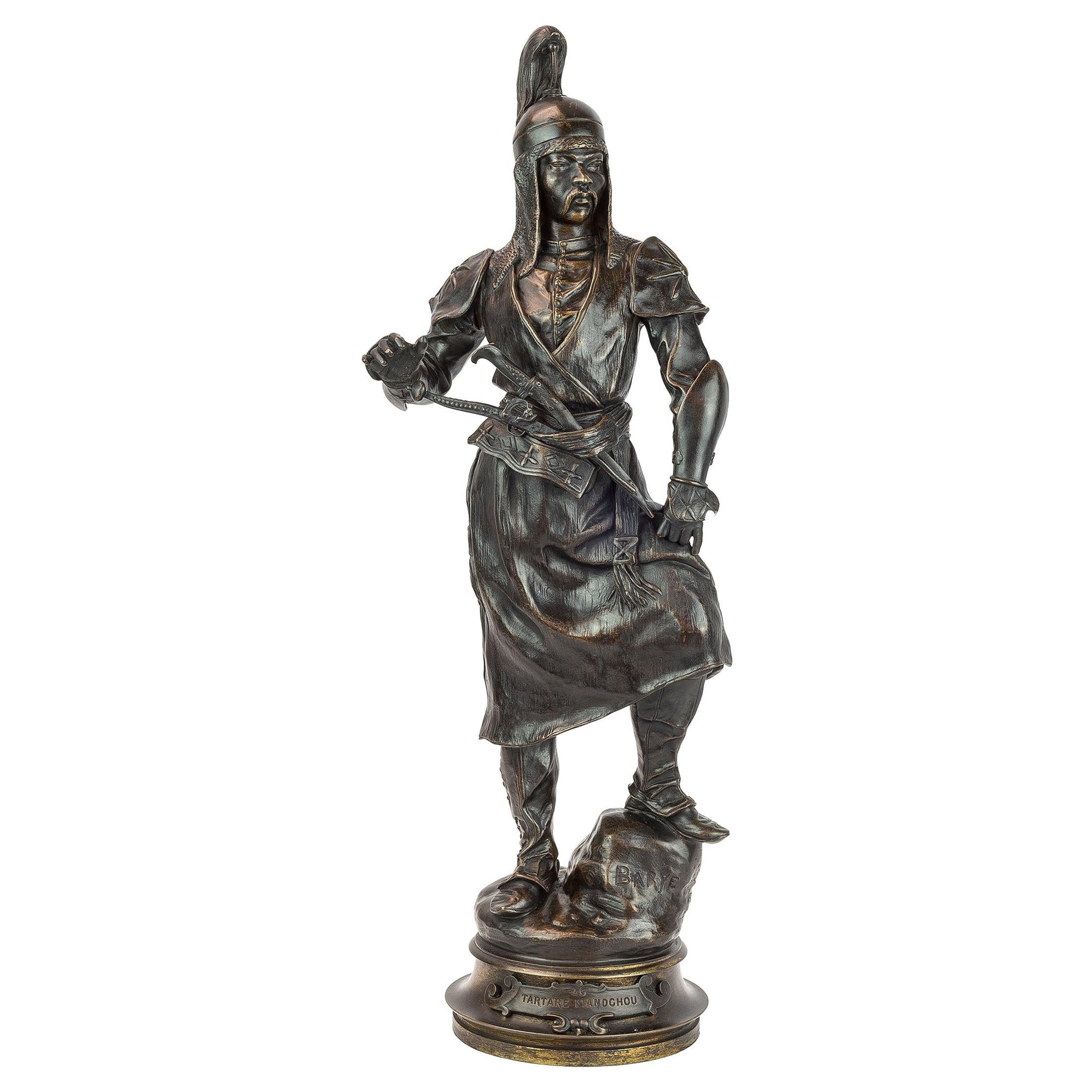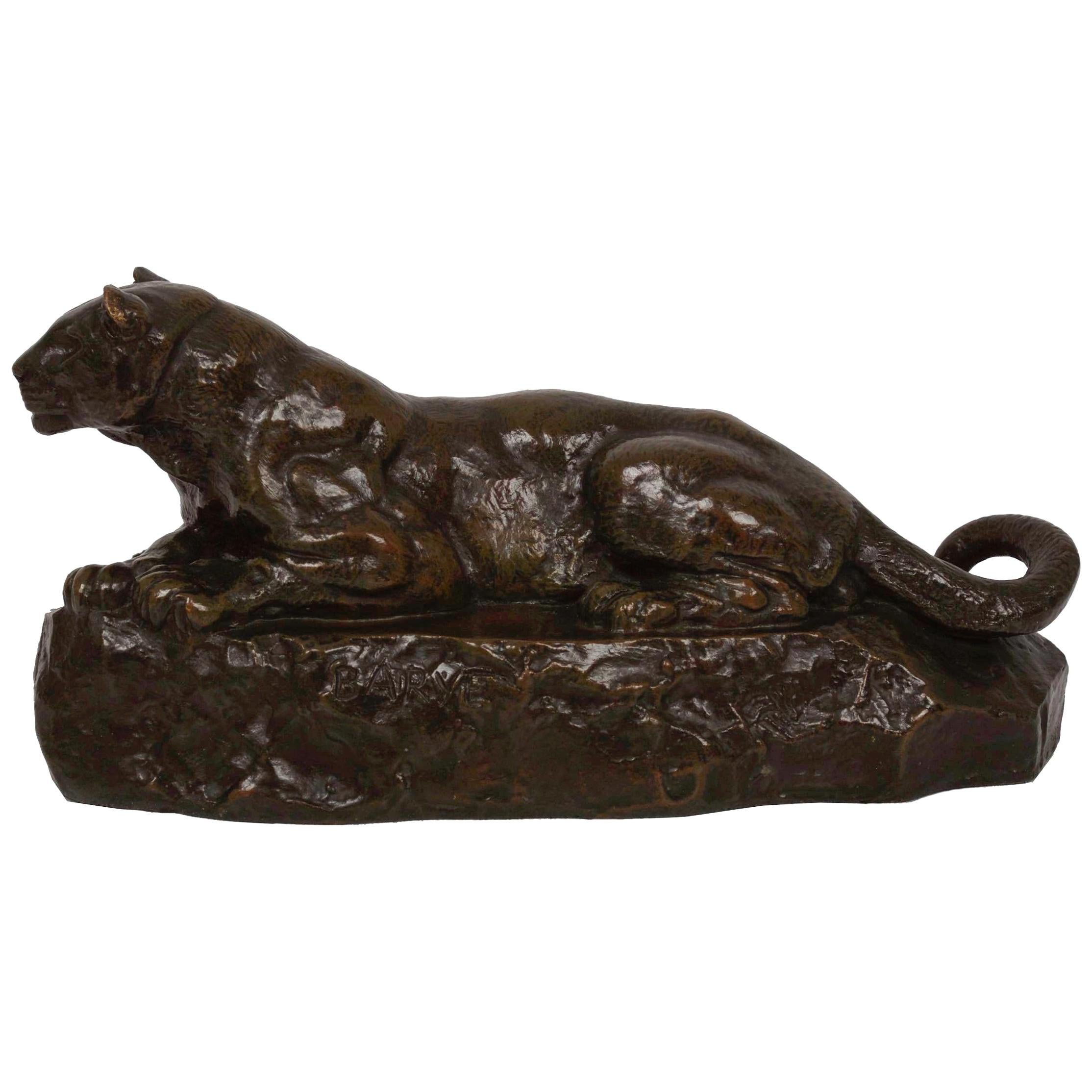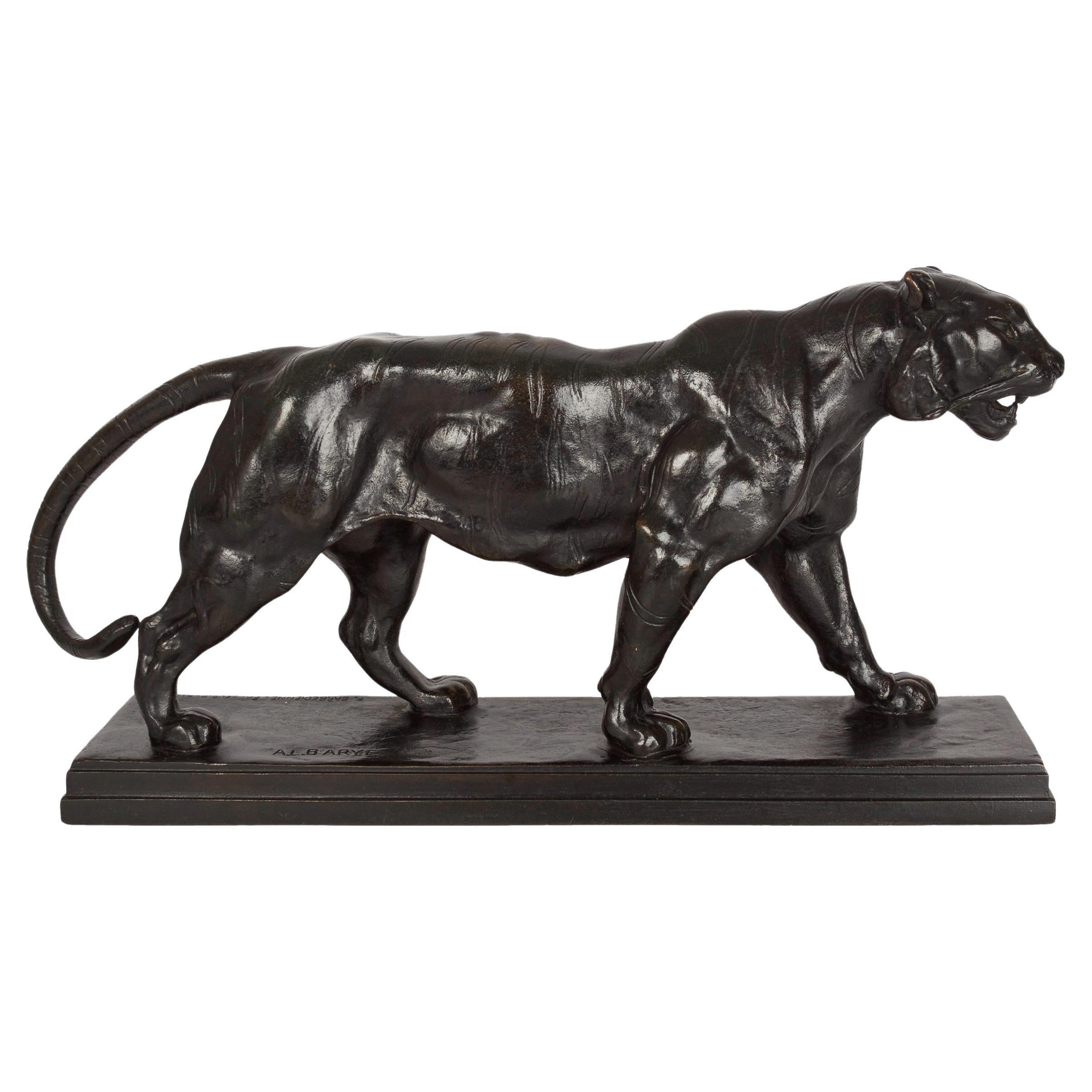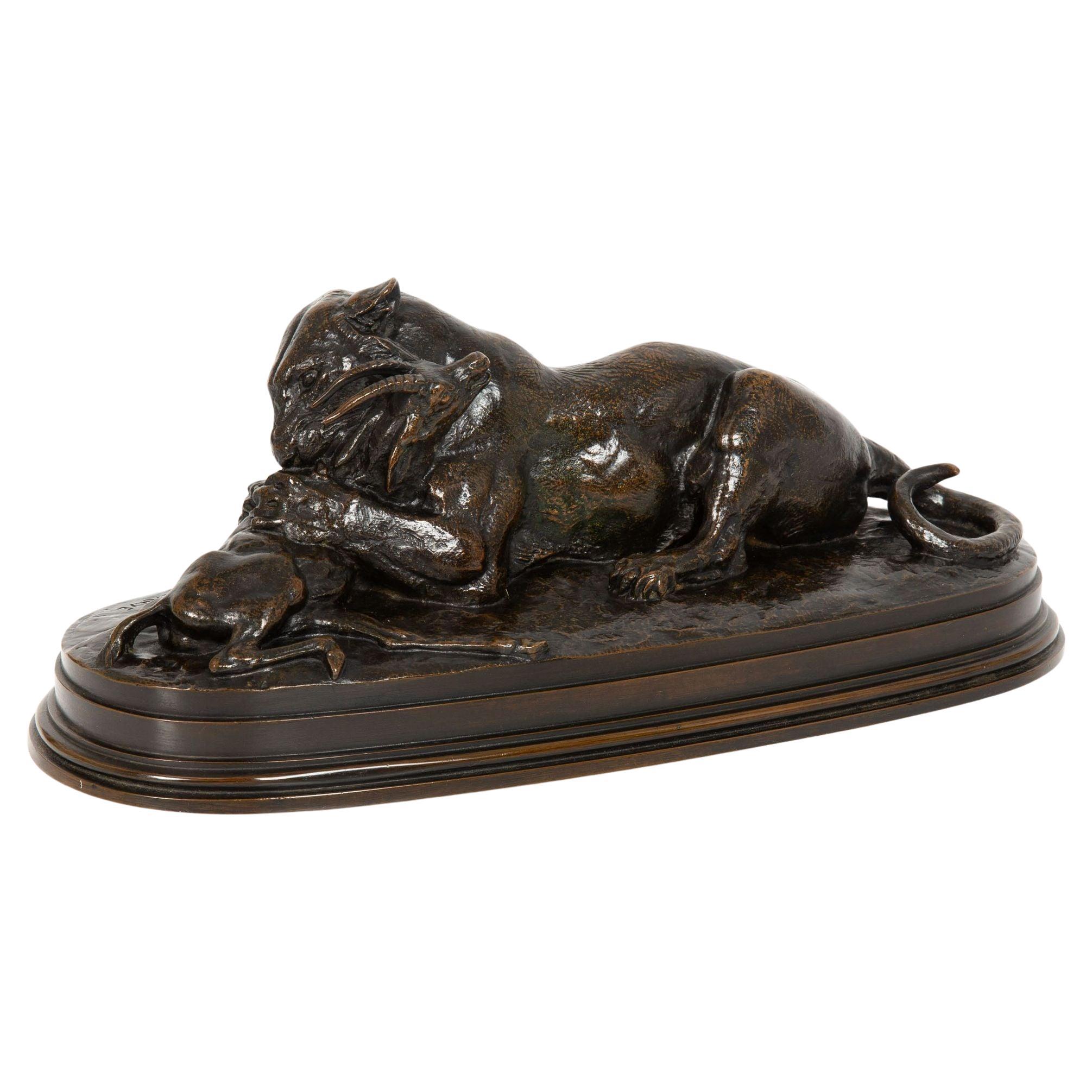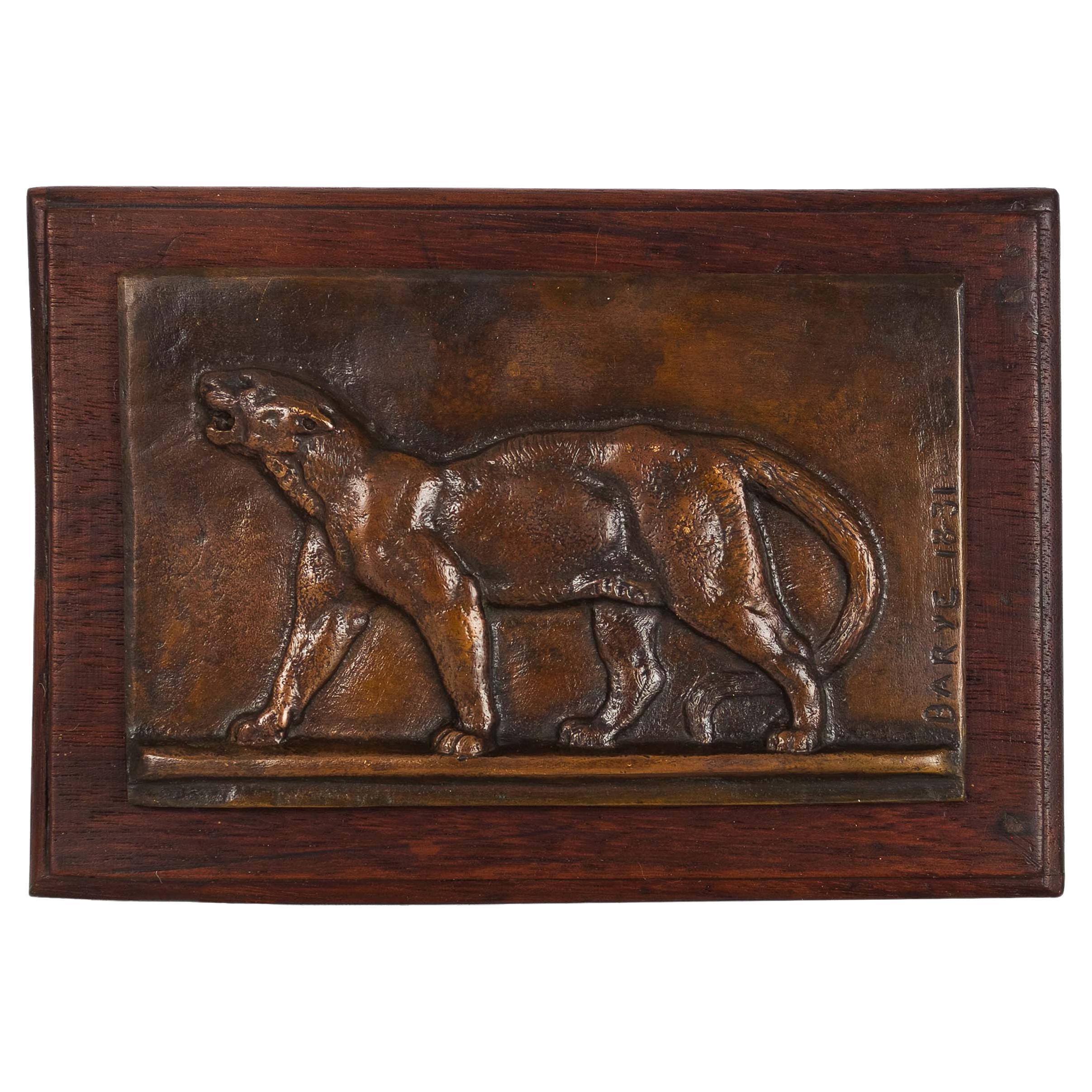Items Similar to A Monumental Bronze Sculpture of "Tartar Warrior Checking His Horse" after Barye
Want more images or videos?
Request additional images or videos from the seller
1 of 9
A Monumental Bronze Sculpture of "Tartar Warrior Checking His Horse" after Barye
About the Item
A Monumental Equestrian Patinated Bronze Group Sculpture of "Tartar Warrior Checking His Horse" after the original model by Antoine Louis Barye (French, 1795-1875). The large and heavy brown patinated sculpture depicting a male warrior in full armor riding his horse. The Tartars were fierce warriors. They were mounted archers who used speed, mobility and shock-power to overwhelm their enemies. Unsigned. Circa: Last quarter of 20th Century.
Antoine-Louis Barye’s masterful sculptures of animals—which included both miniatures and monumental pieces—earned him commissions from aristocrats and royals in France and made him a prominent member of Les Animaliers, a group of French artists who specialized in realistic renderings of animals. Barye’s depictions of animals, such as Tiger Surprising an Antelope (1857), illustrate the artist’s expert understanding of anatomy. This skill earned him the admiration of Auguste Rodin, who studied briefly with Barye at the Muséum d’Histoire Naturelle. After some initial metalwork training from his father, a goldsmith, Barye studied under master goldsmith Martin-Guillaume Biennais and sculptor François-Joseph Bosio before attending the École des Beaux-Arts. He first exhibited at the Salon in 1827, and he garnered attention and praise at his 1831 Salon showing for a sculpted scene of violent predators in the wilderness. Barye was commissioned to sculpt allegorical groups representing Strength, Order, Peace, and War for the façade of the Musée du Louvre as well as a series of decorative masks for the Pont Neuf, among other prominent public works.
Literature:
Jane Horswell, Bronze Sculpture of 'Les Animaliers', Reference and Price Guide, Suffolk, 1971, p. 45, illus. of another cast
Stuart Pivar, The Barye Bronzes, Woodbridge, 1974, illus. on the cover and p. 59, F9, another model shown with differing base
M. Poletti and A. Richarme, Barye. Catalogue raisonné des sculptures, Paris, 2000, pp. 76-77, no. F10, illus. of another cast
Height: 57 inches (144.8 cm)
Width: 57 inches (144.8 cm)
Depth: 24 1/2 inches (62.2 cm)
- Similar to:Antoine-Louis Barye (Sculptor)
- Dimensions:Height: 57 in (144.78 cm)Width: 57 in (144.78 cm)Depth: 24.5 in (62.23 cm)
- Style:Islamic (In the Style Of)
- Materials and Techniques:Bronze,Patinated
- Place of Origin:
- Period:
- Date of Manufacture:Circa: Last quarter of 20th Century
- Condition:Wear consistent with age and use. Minor fading. A truly beautiful and large sculpture, great for indoor or an outdoor fountain. Please view all images.
- Seller Location:Los Angeles, CA
- Reference Number:
About the Seller
5.0
Vetted Seller
These experienced sellers undergo a comprehensive evaluation by our team of in-house experts.
Established in 1982
1stDibs seller since 2016
114 sales on 1stDibs
Typical response time: <1 hour
- ShippingRetrieving quote...Ships From: Los Angeles, CA
- Return PolicyThis item cannot be returned.
More From This SellerView All
- After Gaston Leroux French 19th Century Bronze Sculpture of RebeccaBy Gaston Veuvenot LerouxLocated in Los Angeles, CAA fine French 19th-20th century orientalist silvered and gilt patinated bronze sculpture of "Rebecca" with a plaque that reads "Jeune Fille Arabe" (A Young Arab Girl - Water-Carrier)...Category
Antique Early 1900s French Greco Roman Figurative Sculptures
MaterialsBronze
- Italian 19th Century Grand Tour Bronze Sculpture of Narcissus, after PompeiiLocated in Los Angeles, CAAn Italian 19th century grand tour - Greco Roman bronze sculpture of Narcissus, after the original sculpture excavated in 1862 at Pompeii. The green...Category
Antique 19th Century Italian Greco Roman Figurative Sculptures
MaterialsBronze
- Italian 19th Century Bronze Sculpture Group of a Two-Horse Roman Chariot & RiderLocated in Los Angeles, CAA fine and large Italian 19th century Greco Roman style brown patinated bronze sculpture group of a two-horse Roman Chariot and rider in a dark patina, raised on a fitted Verde d'alp...Category
Antique 19th Century Italian Greco Roman Figurative Sculptures
MaterialsMarble, Bronze
- Pair French 19th/20th Century Gilt-Bronze Sculptures of The Marly Horses LampsBy Guillaume CoustouLocated in Los Angeles, CAA Fine Pair of French 19th/20th Century Gilt-Bronze Sculptures of "The Marly Horses" (Now turned into lamps) After the original by Guillaume Coustou (French, 1677-1746). The large pair of equestrian bronze sculptures, finished in a gold patina, each depicting rearing horses with their groom, both raised on oval a black slate and Bardiglio marble bases and fitted with modern electrical twin-light brass fittings and cream colored shades. The base on an ebonized wooden platform. Circa: Paris, 1900-1920. Sculpture & Base Height: 31 1/4 inches (79.8 cm) Base Width: 21 3/4 inches (55.3 cm) Base Depth: 12 3/4 inches (32.4 cm) Height to top of (Adjustable) shade fitting: 48 1/4 inches (122.6 cm) Shade Height: 15 inches (38.1 cm) Shade Width: 26 inches (66.1 cm) Shade Depth: 20 inches (50.8 cm) The original Marly Horses are two 1743–1745 Carrara marble sculpted groups by Guillaume Coustou. They were commissioned by Louis XV of France for the trough at the entrance to the grounds of his château de Marly. Coustou's last works, they were intended to replace two other sculpted groups, Mercury on Pegasus and Pegasus, Renown of Horses, both by Antoine Coysevox, which had been removed to the Tuileries Gardens in 1719. Louis XV chose the modellos in 1743 and the full-size sculptures were completed in only two years, being installed at Marly in 1745. They proved highly successful in reproduction, particularly on a smaller scale, and prefigured Théodore Géricault and other Romantic artists' obsession with equestrian subjects. The Marly horses were later also used as the central motif of the monochrome 819-line RTF/ORTF test card which was used on TF1 from 1953 until 1983. The originals were moved to the place de la Concorde in Paris in 1794 and Louis-Denis Caillouette (1790–1868) restored them in 1840. In 1984 it was concluded that the annual military parades on 14 July were damaging the sculptures and they were replaced by marble copies produced by Michel Bourbon in the studio of a subsidiary of Bouygues. The latter also gained the right to an extra copy, which was placed in Bouygues's social building. The original sculptures were moved to a former courtyard in the Richelieu wing of the Louvre Museum, which was renamed the 'cour Marly' in their honour, whilst Bourbon's two main copies were moved to the originals' first site near the trough at Marly, with work overseen by the architect Serge Macel. Guillaume Coustou the Elder (29 November 1677, Lyon – 22 February 1746, Paris) was a French sculptor of the Baroque and Louis XIV style. He was a royal sculptor for Louis XIV and Louis XV and became Director of the Royal Academy of Painting and Sculpture in 1735. He is best known for his monumental statues of horses made for the Chateau of Marly, whose replicas now stand in the Place de la Concorde in Paris. Coustou was a member of a family of famous sculptors; his uncle, Antoine Coysevox, was a royal sculptor; his elder brother, Nicolas Coustou was a sculptor, and his son Guillaume Coustou the Younger also become a noted royal sculptor. Like his older brother, he won the (Prix de Rome) of the Royal Academy which entitled him to study for four years at the French Academy in Rome. However, he refused to accept the discipline of the academy, gave up his studies, set out to make his own career as an artist. He worked for a time in the atelier of the painter Pierre Legros, and eventually returned to Paris. Upon his return to Paris, he assisted his uncle Coysevox in making two monumental equestrian sculptures, Fame and Mercury, for the Château de Marly, the new residence of Louis XIV near the Palace of Versailles, where he went to escape the crowds and ceremony of the Palace. He later (1740–1745), made his own horses, The Horses of Marly, his most famous works, to replace them. The horses reinvent the theme of the colossal Roman marbles of the Horse Tamers in the Piazza Quirinale, Rome. They were commissioned by Louis XV in 1739 and installed in 1745 at the Abreuvoir ("Horse Trough") at Marly. The horses were considered masterpieces of the grace and expressiveness of the French Late Baroque or Rococo style. After the Revolution they were moved from Marly to the beginning of the Champs-Élysées on the Place de la Concorde. The originals were brought indoors for protection at the Louvre Museum in 1984. In 1704 Coustou was received into the Académie royale de peinture et de sculpture. The work he made to mark his entrance was Hercules on the Pyre, now in the Louvre. It displays the special hallmark of the Baroque, a twisting and rising transverse pose, as well as highly skillful carving. He rose to become Director of the academy in 1733. Another of his major works from his later career, the statue of Maria Leszczynska, (1731)is on display at the Louvre. Coustou also created two colossal monuments, The Ocean and the Mediterranean among other sculptures for the park at Marly; the bronze Rhone, which formed part of the statue of Louis XIV at Lyons, and the sculptures at the entrance of the Hôtel des Invalides. Of these latter, the bas-relief representing Louis XIV mounted and accompanied by Justice and Prudence was destroyed during the Revolution, but was restored in 1815 by Pierre Cartellier from Coustou's model; the bronze figures of Mars and Minerva (1733–34), on either side of the doorway, were not interfered with. In 1714 for Marly he collaborated in two marble sculptures representing Apollo Chasing Daphne (both at the Louvre), in which Nicolas Coustou sculpted the Apollo and Guillaume the Daphne. About the same time he was commissioned to produce another running figure in marble, a Hippomenes designed to complement an Atalanta copied from the Antique by Pierre Lepautre...Category
Antique Early 1900s French Louis XV Animal Sculptures
MaterialsMarble, Bronze
- After Julien Dillen Marble Sculpture of "Femme au Bouquet"By Julien DillenLocated in Los Angeles, CAAfter Julien Dillen (Belgian, 1849-1904) A Large Carved Marble Sculpture of "Femme au Bouquet" depicting a kneeling young nude girl with a bouquet of ro...Category
20th Century Unknown Romantic Figurative Sculptures
MaterialsMarble
- Monumental Japanese Meiji Period Bronze Censer Urn with DragonsLocated in Los Angeles, CAA monumental Japanese Meiji period bronze censer urn, the elaborate multi-section exhibition piece with large high-relief dragon 'handles' to either side of the ovoid body with two s...Category
Antique 19th Century Japanese Meiji Figurative Sculptures
MaterialsBronze
You May Also Like
- Fine Patinated Bronze Sculpture of a Manchu Tartar by BaryeBy Antoine-Louis BaryeLocated in New York, NYAntoine-Louis Barye French, (1796-1875) Manchu tartar Patinated bronze; Signed BARYE on base Measure: 21 x 8 1/2 inches.Category
Antique 19th Century French Figurative Sculptures
MaterialsBronze
- Bronze Sculpture "Panther of Tunisia" After Antoine-Louis Barye, BarbedienneBy Antoine-Louis Barye, F. Barbedienne FoundryLocated in Shippensburg, PA"PANTHÈRE DE TUNIS NO. 2" AFTER A MODEL BY ANTOINE-LOUIS BARYE (FRENCH, 1796-1875) Signed in base "BARYE", incised to edge "F. Barbedienne Fondeur"; underside incised "24 / Z"; cast ...Category
Antique 19th Century French Romantic Animal Sculptures
MaterialsBronze
- Bronze Python Killing Gnu Sculpture after Antoine-Louis BaryeBy Antoine-Louis BaryeLocated in Fort Washington, MDMagnificent high quality reproduction of Antoine-Louis Barye‘s famous Python Killing Gnu, cast in bronze with a 1” black marble base. This piece it’s large and heavy and would be and...Category
Mid-20th Century Unknown Animal Sculptures
MaterialsMarble, Bronze
- French Bronze Sculpture "Tiger Walking" after Antoine-Louis Barye, BarbedienneBy F. Barbedienne Foundry, Antoine-Louis BaryeLocated in Shippensburg, PAANTOINE-LOUIS BARYE French, 1795-1875 "Tigre Qui Marche" Dark brown patinated bronze Signed in base "A.L. BARYE", incised "F. BARBEDIENNE FONDEUR, PARIS", cold-stamped FRANCE cold-tooled to underside 19.691 conceived 1841, cast circa early 20th century Item # 111GPP20Q Barye's ability to merge our romantic idealization of nature with a colder reality of nature's predator is beautifully represented in this striding cat. Originally conceived in 1841, Tigre Qui Marche (Walking Tiger...Category
Early 20th Century French Romantic Animal Sculptures
MaterialsBronze
- French Bronze Sculpture “Tiger Devouring Gazelle” after Antoine-Louis BaryeBy Antoine-Louis BaryeLocated in Shippensburg, PAANTOINE-LOUIS BARYE French, 1795-1875 "Tigre Dévorant une Gazelle (second edition)" Medium-brown autumnal patinated sand-cast bronze Signed in cast "BARYE", incised "F. BARBEDIENN...Category
Antique 19th Century French Romantic Animal Sculptures
MaterialsBronze
- French Bronze Sculpture Bas-Relief "Walking Leopard" after Antoine-Louis BaryeBy Antoine-Louis BaryeLocated in Shippensburg, PAANTOINE-LOUIS BARYE (AFTER) France, 1796-1875 "WALKING LEOPARD" (conceived 1831, cast circa 1890-1910) Patinated bronze bas-relief plaque on walnut panel Signed "BARYE 1831" Item # 110CFX23P A beautifully textured and well-preserved bas-relief plaque after Antoine-Louis Barye's Walking Leopard mounted...Category
Antique 19th Century French Romantic Animal Sculptures
MaterialsBronze
Recently Viewed
View AllMore Ways To Browse
Vintage Hummel
Vintage Clown Statue
Alessandro Mendini Original Proust Armchair Italy
Ceramic Gnome
Russian Enamel Belt
Vintage German Scooters
Allan Winkler
Bing Og Grondahl
Crab Statue
Jim Davidson Sculptures
Johannes Bjerg
Lee Menichetti
Saint Florian
Salvador Furio
The Sunbather Sculpture
Venini Mask
Wicker Motorcycle
5 Carrot
